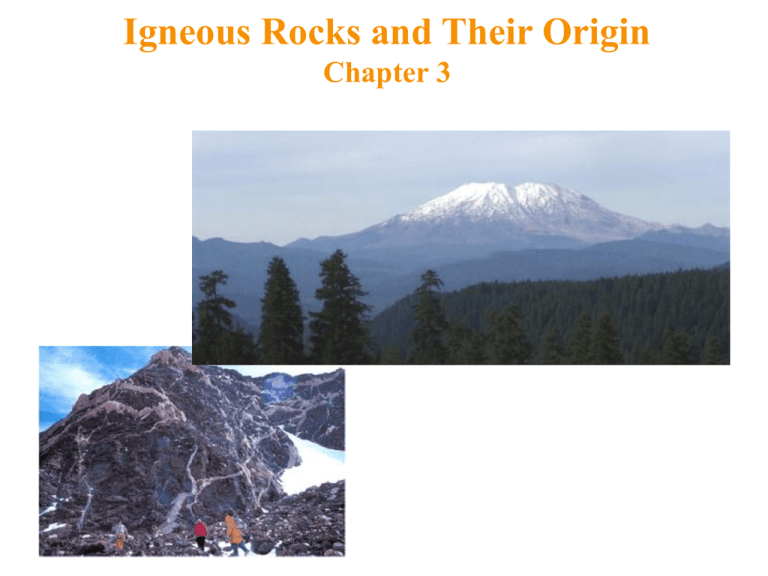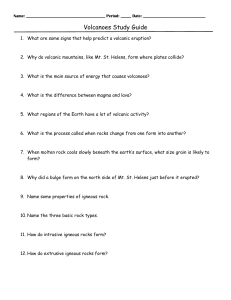Igneous Rocks and Their Origin Chapter 3
advertisement

Igneous Rocks and Their Origin Chapter 3 The Rock Cycle • A rock is composed of grains of one or more minerals • The rock cycle shows how one type of rocky material is transformed into another Three Types of Geologic Rocks • Igneous rocks - Formed from volcanic eruptions - either intrusive or extrusive • Sedimentary rocks - Formed from deposition and erosional processes • Metamorphic rocks - Deforming of rocks above from exposure to high pressure and temperature The Rock Cycle and Plate Tectonics • Magma is created by melting above a subduction zone • Less dense magma rises and cools to form igneous rock • Igneous rock exposed at surface gets weathered into sediment • Sediments transported to low areas, buried and hardened into sedimentary rock • Sedimentary rock heated and squeezed at depth to form metamorphic rock Volcanism and Extrusive Rocks (Chapter 4) Mount St. Helens Hawaii What differences do you see in these two volcanoes ? How are these Volcanoes Different? Hawaii Mt St. Helen's Types of Volcanoes 1. Shield Volcano (Hawaiian) - Low viscosity “runny” lava - Shallow slopes (shield volcanoes) - Low silica content 2. Strato Volcano (Mt. St. Helens) * Strombolian -Intermediate explosivity -Can eject showers of lava * Plinian - High viscosity lava - Steep slopes (stratovolcanoes) - High silica content Shield Volcano © 2008, John Wiley and Sons, Inc. Flood Basalts from Snake River Plates, Idaho © 2008, John Wiley and Sons, Inc. Stratovolcano Steep slopes formed by high viscosity, silica rich magmas © 2008, John Wiley and Sons, Inc. How a stratovolcano is formed © 2008, John Wiley and Sons, Inc. Extrusive Volcanic Rocks: - Large volcanic bombs - Intermediate tephra - Small ash © 2008, John Wiley and Sons, Inc. Volcanoes and Volcanic Hazards Mount Etna, Sicily experienced a Strombolian eruption in 2002 © 2008, John Wiley and Sons, Inc. Lakes of Death in Cameroon © 2008, John Wiley and Sons, Inc. Volcanic Gases © 2008, John Wiley and Sons, Inc. Deadly eruptions Figure 6.10 © 2008, John Wiley and Sons, Inc. Laki Volcano, Iceland - Fissure eruption 1783 – 1784 - Largest lava flow in recorded history - Winter after eruption temperature dropped 1oC - 2.5oC. © 2008, John Wiley and Sons, Inc. Volcanic Gases form Earth's Atmosphere and Oceans * Gas clouds from volcanic eruptions help form our atmosphere * How would this process explain the different atmospheres on other planets and habitability ? Volcanic Gases form Earth's Atmosphere and Oceans Mount St. Helens Hawaii * Which type of volcano do you think releases more gases into the atmosphere during an eruption ? - Shield Volcano - Strato Volcano Volcanoes on Mars * Which type of volcano do you think Olympus Mons is on Mars ? * How would Olympus Mons contribute to it's atmosphere ? Mars Atmosphere Carbon dioxide Nitrogen Argon Oxygen 95% 3% 1.5% Trace amounts only Atmospheric pressure is only 1% of Earth so does not protect surface from Sun's radiation What Causes Volcanic Eruptions ? Press & Siever Fig. 1.16 Types of Igneous Rocks • Magma is molten rock • Igneous rocks form when magma cools and solidifies – Intrusive igneous rocks form when magma solidifies underground Granite • Granite is a common example – Extrusive igneous rocks form when magma solidifies at the Earth’s surface (lava) • Basalt is a common example Basalt Extrusive Volcanic Rocks: - Large volcanic bombs - Intermediate tephra - Small ash © 2008, John Wiley and Sons, Inc. How do we Know Igneous Rocks Formed at Depth? Torres del Paine, Chile • Mineralogy / Chemistry ? • Grain size (coarse vs fine grained) • Lab experiments require high P & T to form large grains • Outcrops: See intrusions into country rock -Contact/chill zones, baked and metamorphosed • Xenoliths of country rock found in igneous intrusions Igneous Rock Textures • Texture refers to the size, shape and arrangement of grains • Texture of igneous rocks is controlled by cooling rate • Extrusive rocks cool quickly at the Earth’s surface and are fine-grained (small <1 mm) • Intrusive rocks cool slowly deep beneath Earth’s surface and are coarse-grained (large >1 mm) Fine-grained igneous rock Coarse-grained igneous rock Special Igneous Textures • A pegmatite is a very coarse-grained rock (crystals >5 cm) formed when magma cools very slowly at depth • A glassy texture contains no crystals at all, and is formed by rapid cooling • A porphyritic texture includes two crystal sizes, formed first during slow cooling (large crystal) and then forming small crystals during rapid cooling Pegmatitic igneous rock Porphyritic igneous rock Igneous Rock Identification • Igneous rock names are based on texture (grain size) and composition Textural classification • – – • Coarse-grained: Plutonic rocks (gabbro-diorite-granite) cooled slowly at depth Fine-Grained: Volcanic rocks (basalt-andesite-rhyolite) cooled rapidly at the Earth’s surface Compositional classification – – – Mafic rocks (gabbro-basalt) contain dark-colored ferromagnesian minerals, iron rich (50% silica) Intermediate rocks (diorite-andesite) contain roughly equal amounts of dark- and light-colored minerals Felsic rocks (granite-rhyolite) light-colored minerals, silica rich (65%) Igneous Rock Identification Olivine Igneous names are based on 1) texture and 2) mineralogic composition Intrusive Rock Bodies • Intrusive rocks exist in bodies or structures that penetrate or cut through pre-existing country rock • Shallow intrusions: Dikes and sills • • Form <2 km beneath Earth’s surface Chill and solidify quickly in cool country rock Intrusive Rock Bodies Plutons: deep magmatic intrusions - Form at considerable depth beneath the surface when rising blobs of magma (diapirs) get trapped within the crust Pluton in Ship Rock, New Mexico Intrusive Rock Bodies • Volcanic neck – • Shallow intrusion formed when magma solidifies in throat of volcano Dike – • Light-colored dikes Tabular intrusive structure that cuts across any layering in country rock Sill – Tabular intrusive structure that parallels layering in country rock Basaltic sill Sierra Nevada batholith






